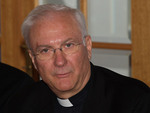 Archbishop Piero Marini, until October of this year the Vatican Master of Pontifical Liturgical Celebrations, has just published a book, A Challenging Reform: Realizing the Vision of the Liturgical Renewal, 1963-1975
Archbishop Piero Marini, until October of this year the Vatican Master of Pontifical Liturgical Celebrations, has just published a book, A Challenging Reform: Realizing the Vision of the Liturgical Renewal, 1963-1975At the moment in the canonization Mass when John Paul read out the Latin formula declaring Juan Diego a saint, pandemonium broke out in the Basilica of Our Lady of Guadalupe. Confetti fell from the ceiling, drums beat and horns blared, and a knot of indigenous dancers began to gyrate down a catwalk. Inside, it felt like Michael Jordan had just hit the winning shot in Game Seven of the NBA Finals; an American TV correspondent standing next to me, who happens to be Jewish, shouted in my ear, “If they did it this way every Sunday, even I would show up!”
The next day, when John Paul beatified two indigenous martyrs, the atmosphere was equally electric. Once again, confetti fell, music rang out, and native dancers did their thing. The dancers in this case were Zapotec Indians from the State of Oxaca, but there was a notable difference from the day before. In their midst was an elderly female shaman carrying a cluster of burning herbs. She performed a purification ritual known as a limpia, believed to drive off evil spirits. The shaman ritualistically brushed the herbs first on Cardinal Norberto Rivera Carrera, and then on John Paul II himself.
In effect, the shaman performed an exorcism on the pope.
Watching this surreal scene play out, I couldn’t help but wonder what the personnel in the Congregation for Divine Worship and the Discipline of the Sacraments, the Vatican office responsible for policing the liturgical rules, were thinking. I took out my cell phone and dialed the number of a friend who, at the time, worked in the congregation. I asked if he had seen the ceremony on Vatican TV, which he had, and then I asked for the reaction in the office.
Summoning his deepest baritone, the official thundered back a three-word reply: “Marini must go!”
 Marini, of course, was responsible for organizing all the major liturgical events presided over by the pope, whether in Rome or on the road. Hence he gets the credit or blame whenever something pushed the envelope -- such as the exorcism in Mexico City, or the scantily clad Pacific islanders who danced for the pope in St. Peter’s Basilica during the opening of the 1998 Synod for Oceania.
Marini, of course, was responsible for organizing all the major liturgical events presided over by the pope, whether in Rome or on the road. Hence he gets the credit or blame whenever something pushed the envelope -- such as the exorcism in Mexico City, or the scantily clad Pacific islanders who danced for the pope in St. Peter’s Basilica during the opening of the 1998 Synod for Oceania.Marini, says Allen, is regarded as perhaps the leading advocate of progressive reform in Catholic liturgy -- the democratization of liturgical control, "inculturation," innovation, and all the rest of the legacy with which we're all too familiar.
Among other things, Allen says:
Marini’s book tells the story of the Consilium, the body created during Vatican II to oversee the implementation of the council’s decree on liturgy, Sacrosanctum Concilium. The Consilium was always an anomaly in the Vatican: it had no juridical authority of its own, yet at the peak of its influence it enjoyed virtually unchallenged sway over liturgical policy; it was led by a wide international assortment of bishops and liturgical experts, most of them not part of the Roman Curia; and it consulted widely with bishops’ conferences, national liturgical organizations and publishers of liturgical texts, usually backing their views over opposition from the dicasteries of the Vatican.Marini nowhere mentions Benedict or his recent Motu Proprio, Summorum Pontificum liberalizing the old Latin Mass. In fact, his account ends in 1980. But it is clearly an informative retrospective, if not swansong, of a champion of the liturgical revolution that many thought they read in the tea leaves of the "Spirit of Vatican II," which certainly went far beyond anything envisioned by the Council's Constitution on the Sacred Liturgy, Sacrosanctum Concilium. Allen's review is long, thorough, and well worth reading.* * * * * * *
The Consilium’s crowning achievement was the Novus Ordo, the new Mass, issued by Pope Paul VI in 1969 to replace the Tridentine rite codified five centuries earlier as the normal way Catholics worship.
Archbishop Marini's book publication was feted today at Archbishop Murphy-O’Connor's House in Westminster in London. Marini and company are scheduled to be on the road in the United States promoting A Challenging Reform: Realizing the Vision of the Liturgical Renewal, 1963-1975
- Feb 11-12: Boston College
- Feb 13: Catholic Theological Union in Chicago
- Feb 13-15: University of Notre Dame
- Feb 15-17: New York and the United Nations, with a luncheon hosted by America magazine
[Hat tip to S.F.]

No comments:
Post a Comment